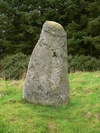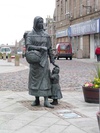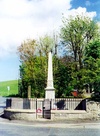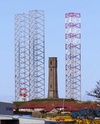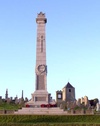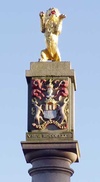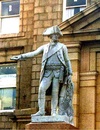|
As part of an attempt to regenerate the area and preserve the historic associations of the pends and closes running back from the street they were given these canopies with cut metal signs,
1: Smithy Close: named after a smiddy that was there in the 19th and early 20th century, the canopy depicts a Clydesdale horse and a representation of show harness is inset into the close threshold stone.
In the comparatively short period of its ascendancy, between the period of the ox plough and the tractor, the horse had a huge impact on local culture (reaching its apotheosis in the magico/religious elements of the "Horseman's Word" secret societies) and still exerts an influence although it has gone from most people's everyday life.
2: Proclamation Pend: Shortly after the beginning of the 1715 Jacobite Rebellion, George Keith, 9th Earl Marischal of Scotland, read out a proclamation, at the nearby Peterhead Tolbooth, stating that James Stuart (father of Bonnie Prince Charlie), was the rightful King of Britain. The Earl was accompanied by his younger brother James Keith, later to become a field marshal in Frederick the Great's Prussian army.
James Stuart landed at Peterhead from France on the 22nd of December 1715 and stayed overnight before proceeding South. He returned to France in February 1716 after the failure of the rising.
The canopy shows three figures at the reading of the proclamation and the Keith clan crest is inset into the threshold.
3: Tolbooth Close: named after the Tolbooth which was nearby on the site of the present Townhouse. The Tolbooth was the centre of administration, justice and ceremonial life, where tolls and customs were collected. It was also used for meetings of the burgh council and court and as a prison for remanded criminal suspects and debtors.The original Peterhead Tolbooth was erected in the Longate toward the end of the 16th century, a new one was built in the Broadgate in the 1660s, this was demolished in 1786 and the present Townhouse erected in 1788. The canopy shows a prisoner behind bars and a representation of a James VI eight penny peice is inset into the threshold.
4: Empress Close: named after the Empress Ballroom which occupied the ground floor of the Music Hall that once stood here, the canopy shows a dancing couple, dance step patterns are inset into the threshold.
5: Drummer's Close: named after Drummer's Corner which was situated at the other side of Marischal Street. Woollen mill worker James Milne was an army drummer in the Crimean War (1853-56) he returned to Peterhead and kept a small shop, at the corner of Marischal Street and Albion Street, as well as being the town drummer, his premises became known as 'Drummer's Corner', the canopy shows a drummer with a series of pipe band drummers inset into the threshold.
More Information
|
|
The artist (Dutch film maker, Jean Bei Ning) filmed local residents walking in front of a mobile blue screen. This footage was then mounted into slides showing landmarks in Tibet, Africa, Scotland, Thailand, Syria and Indonesia. This created the effect that local people were travelling in 'other worlds'. The artist also produced a sound piece located elsewhere in the town consisting of stories recorded in interviews with local people.
More Information
|
|
It is a tall rectangular obilisk with an unusual decorated top. The name plaques are near the base of the sides within egg & dart borders, each surmounted by a wreath. Above the wreath on one face is a cross. The obilisk stands on a slightly splayed base on top of a three-step base. It was unveiled 6 August 1922 and handed over to the Town Council on August 6 1923. The World War II memorial forms the gate piers in to the churchyard. They are squat rectangular pillars with the coats-of-arms of the different services and regiments as well as the names. Inside the churchyard is another memorial to the men buried in the churchyard and three other war graves.
More Information
|
|
One of several ornate carved 19th century datestones on buildings in the town centre. The pink Peterhead granite is the towns signature material. The metal spikes are an attempt to limit nesting places for the Herring Gulls that throng this fishing port in huge numbers.
More Information
|

